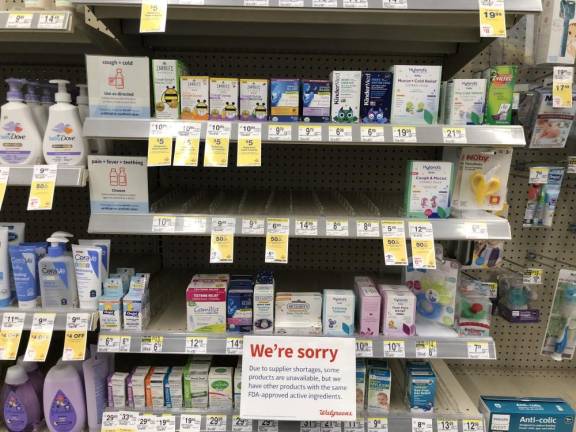As immunity falls, 3 threats rise
Health. The holiday and flu seasons become one as the community grapples with influenza, RSV and COVID-19.


As three viruses make waves across the community, local moms struggled to find fever-reducing medicine for their children in recent weeks.
One mother in Warwick, N.Y., determined to alleviate her son’s symptoms, visited several pharmacies in search of children’s Tylenol, Mucinex or Advil before eventually finding medication at ShopRite.
Another said she visited three stores before she could find a fever-reducer for her child.
A third described visiting six stores in a search for infant Tylenol, just to find empty shelves.
“It’s a little bit of a touch-and-go situation right now because of the tremendous demand,” said Dr. Donald Thomas Allegra, Newton Medical Center’s head of infectious diseases.
An earlier-than-usual flu season, a premature surge in respiratory syncytial virus (RSV) cases and the lingering COVID-19 pandemic are to blame.
RSV, a respiratory virus that causes cold-like symptoms, “is primarily affecting the population under 5 who require liquid Tylenol,” said Allegra.
The early RSV surge, coupled with flu and COVID-19, explains parents’ struggles to find over-the-counter medication for their children.
According to data from the federal Centers for Disease Control and Prevention (CDC), RSV cases across the tri-state area began to climb in the fall, peaking in the first two weeks of November. RSV numbers are still high but are declining.
Flu cases are continuing to climb.
“It’s really gone up rather dramatically in the past few weeks. This is the earliest we’ve seen high levels of influenza activity in over 10 years,” said Allegra.
Unseasonable flu season
After two years of mask-wearing and barely-there flu seasons, both influenza and RSV arrived sooner than expected this fall.
“If you really think about it ... all these respiratory viruses are spread the same way: by close contact with others not wearing a mask,” said Allegra. “And I think all of us got very tired of all the COVID restrictions.”
As COVID guidelines relaxed alongside declining numbers, people began gathering, shopping and mingling mask-less again.
But this time, their immunity to colds and flu had waned.
“We’re seeing a huge upsurge because there’s been no exposure. Every time you’re exposed to one of these viruses, you develop some immunity against subsequent episodes,” explained Allegra. “We haven’t had that stimulation to our immune system.”
A holiday boost
Health-care providers are preparing for an increase in COVID activity after the holiday season.
“With families getting together for the holidays, we’re probably going to have at least a mini-surge in COVID cases,” Allegra said.
Thankfully, the current COVID-19 variants are not nearly as “serious or deadly” as they were in years past. “We’re seeing a lot of outpatients with COVID, but we haven’t had the influx to our ICUs or the respirator use that we had a year ago,” he said.
According to a pair of studies published by the CDC in December, the bivalent booster, which protects against Omicron variants in addition to the original COVID strains, reduces the risk of hospitalization by about 50 percent. Side effects are the same as with the initial vaccine: generally, people have flu-like symptoms a day or two after getting the shot.
“We’ve given all of these vaccines more than 13 billion – billion – times over the past couple of years ... and if there were serious side effects associated with those vaccines, we would certainly know it by now,” Allegra said. “It really has prevented a lot of hospitalizations and deaths. The estimates are in the hundreds of thousands.”
Celebrating safely
While it would be ideal for preventing the spread of disease, asking friends or family to be vaccinated before gathering can be tough.
“I think it’s a politically difficult decision to make because you might upset your relatives,” Allegra said.
There are alternatives. COVID tests are widely available so party-goers easily could test themselves before attending an event. That is particularly important for gatherings with high-risk, immunocompromised or elderly loved ones.
The short incubation period for flu and COVID is something to keep in mind as parties approach. For both viruses, it takes between two and four days from exposure to develop symptoms.
Allegra recommended lying low and practicing COVID-19 precautions, such as social distancing and mask wearing, in the three to five days before attending a gathering.
“I think that’s a very practical thing that everybody can do without stepping on anybody’s toes about demanding things before you come to the party,” he said.